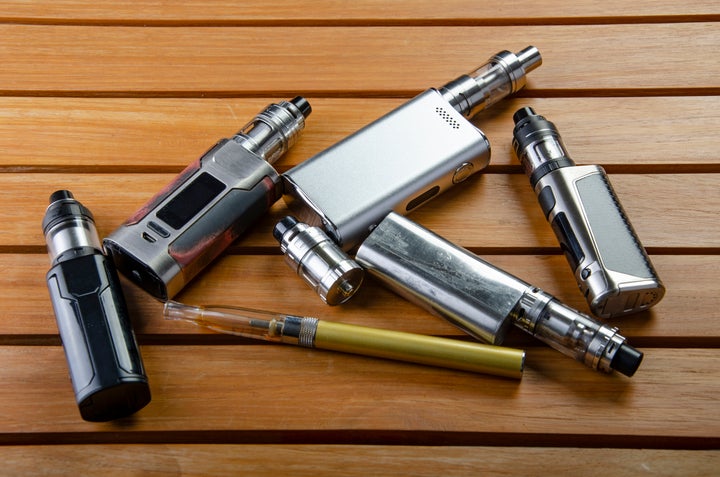The vaping industry is facing a crisis.
Recently, US health officials have linked two deaths and more than 200 cases of severe respiratory diseases to vape pens and e-cigarettes, which have soared in popularity lately.
Many of those affected were teenagers and young adults who were hospitalised for symptoms that got increasingly worse, including shortness of breath, coughing, chest pain, fatigue, vomiting and fevers.
One of the fatalities, a person in Illinois who was identified as being between 17 and 38 years old, had fallen ill after vaping and was hospitalised. The other, an individual in Oregon, had recently been using a vaping device with cannabis purchased from a dispensary.
While health officials haven’t determined an official cause for the surge in vape-related illnesses, researchers who have been running tests on these devices are extremely concerned.
“They’re not safe,” Laura Crotty Alexander, a pulmonologist who has been studying the effects of e-cigarettes since 2013, told HuffPost.
Through her research at the University of California, San Diego, Alexander says, she feels confident enough to say that vape devices are dangerous to users’ health.
“They’re definitely going to cause disease, both in the lungs and throughout the rest of the body,” she said. “We can definitely say now that they are not healthy, they’re not without risk.”
How do vape pens work?
Vape pens and e-cigarettes are battery-powered devices that heat up a combination of chemicals in liquid form, known by some as vape juice, inside a cartridge where it is transformed into an aerosol that is inhaled by the user.
There are three main ingredients in vape juice: vegetable glycerin, propylene glycol and nicotine. Other ingredients are often added for flavour. Some devices use THC or CBD oil, both cannabis derivatives, instead of or in combination with nicotine.
The vegetable glycerin is what produces the visible cloud ― which some call vapor but is actually aerosol ― that users inhale and exhale. Propylene glycol is a solvent that is odourless and absorbs any flavouring that is added to the vape juice. The Food and Drug Administration says glycerin and propylene glycol are “generally recognised as safe.”
The devices come in different shapes and sizes and go by different names, including e-cigs, pods and mods. It has become the most popular alternative to traditional smoking and has caused a rise in teen nicotine use.

What’s up with all the vape-related illnesses?
Despite the apparent surge of illnesses, federal health officials have stopped short of identifying a specific product or ingredient that has caused all these vape-related problems.
In a joint statement, the U.S. Centers for Disease Control and Prevention and the FDA said it wasn’t yet clear what exactly was causing these severe illnesses.
The federal agencies said they needed to continue their investigation of the more than 200 cases they’ve seen so far.
“Even though cases appear similar, it is not clear if these cases have a common cause or if they are different diseases with similar presentations, which is why our ongoing investigation is critical,” the agencies’ statement read.
And though they noted that there doesn’t appear to be one specific product common across all cases, they did note that THC (tetrahydrocannabinol) and cannabinoids known as CBD were involved in many of them.
Is THC or CBD oil to blame?
The CDC recently issued an official health advisory warning people against using vape products that use THC and cannabis. The advisory also urged people to stop buying those devices “off the streets” and told users not to modify or add any new substances to their products.
In an interview with The New York Times, Dr. Scott Gottlieb, a former FDA commissioner, suspected that bootlegged or illegal products may be to blame.
“It’s probably something new that has been introduced into the market by an illegal manufacturer, either a new flavour or a new way to emulsify THC that is causing these injuries,” Gottlieb said.
The CDC announced last month that it was investigating a sudden rise of severe lung illnesses, a majority of which were reported from June to Aug. 15. According to a report published Aug. 20, 30 of those cases occurred in Wisconsin and 24 in Illinois. The illnesses were also reported in New York, California, Indiana and Utah.

Are vape pens dangerous for your health?
Some researchers are convinced they are.
Though vape juice’s core ingredients are safe to consume individually, they can produce harmful substances when they are combined and atomised into an aerosol, according to Alexander.
That byproduct is then ingested into the lungs and can cause damage in the body.
Alexander, who used mice as test subjects, said she’s seen the aerosol alter the immune system, cause inflammation and “direct harm the heart, the kidneys, the liver” when ingested. It also caused “changes in the brain and lungs,” she added.
Some of the vape juice ingredients are producing toxic substances when they are heated during use, including formaldehyde, which has been known to cause cancer, and acrolein, which can damage DNA with prolonged exposure, according to Alexander.
One study by the Desert Research Institute found that formaldehyde is absorbed into vape users’ respiratory tract. University of Minnesota researchers also found DNA-damaging compounds in vape users’ saliva, including acrolein and formaldehyde, after a 15-minute vaping session.
Some doctors are also concerned that vape users are accidentally inhaling oils from the vape juice into their lungs, which can cause inflammation and breathing problems, according to The New York Times.
Thomas Eissenberg, director of Virginia Commonwealth University’s Center for the Study of Tobacco Products, told the Times he had seen seven cases of lung injuries from vaping that had a common ingredient of vegetable glycerin.
“If there is some incomplete process, there can be oil left in the vegetable glycerin when that person is using it, and inhaling oil and getting oil into your lungs is what is causing some of the lung injuries we see,” he told the paper.
There’s a lot we don’t know about vaping, which worries researchers.
The flavours in vape pens are made up of a combination of chemicals that create a flavour profile, according to Alexander. Each of those chemicals can have a different reaction when atomised and ingested as an aerosol, she says, and they can cause different reactions in the body.
The CDC would have to examine the effects of each of the flavours’ chemical makeups in all the different vape products in order to figure out which combinations are harmful and which are not.
Even worse: We won’t know the long-term effects of vaping for a long time. Vaping only started becoming popular in 2010, and researchers haven’t had enough time to observe its effects on consistent users, Alexander said.
Based on her own research and other studies she’s seen, Alexander suspects that long-term vaping will likely have negative and severe effects on some users.
“It’s changing the immune system, and that’s always led to disease.”
